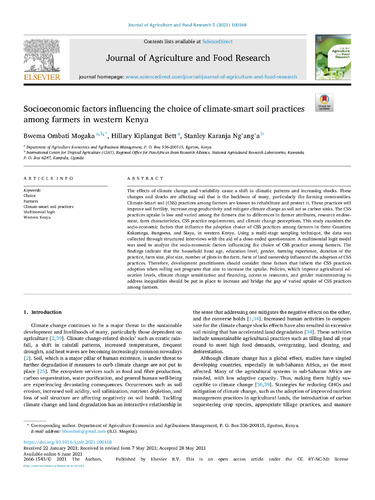Socioeconomic factors influencing the choice of climate-smart soil practices among farmers in western Kenya
The effects of climate change and variability cause a shift in climatic patterns and increasing shocks. These changes and shocks are affecting soil that is the backbone of many, particularly the farming communities. Climate-Smart soil (CSS) practices among farmers are known to rehabilitate and protect it. These practices will improve soil fertility, increase crop productivity and mitigate climate change as soil act as carbon sinks. The CSS practices uptake is low and varied among the farmers due to differences in farmer attributes, resource endow-ment, farm characteristics, CSS practice requirements, and climate change perceptions. This study examines the socio-economic factors that influence the adoption choice of CSS practices among farmers in three Counties: Kakamega, Bungoma, and Siaya, in western Kenya. Using a multi-stage sampling technique, the data was collected through structured interviews with the aid of a close-ended questionnaire. A multinomial logit model was used to analyze the socio-economic factors influencing the choice of CSS practice among farmers. The findings indicate that the household head age, education level, gender, farming experience, duration of the practice, farm size, plot size, number of plots in the farm, form of land ownership influenced the adoption of CSS practices. Therefore, development practitioners should consider these factors that inform the CSS practices adoption when rolling out programs that aim to increase the uptake. Policies, which improve agricultural ed-ucation levels, climate change sensitization and financing, access to resources, and gender mainstreaming to address inequalities should be put in place to increase and bridge the gap of varied uptake of CSS practices among farmers.

